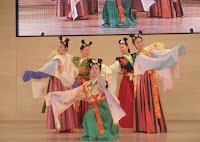




April 24, 2010
Nara excited on commemorative year of Heijo-kyo Capital
Nara excited on commemorative year of Heijo-kyo Capital
Nara is one of the few lively spots in Japan, at a time when the economy remains in the doldrums. Nara, a basin hemmed by mountains and hills around, hosted Heijo-kyo capital from 710 to 794, the period when Japan tried hard to establish itself as a state by importing various cultures and items from the Tang dynasty of China. (Readers may be advised to see the post released on Jan. 31.)
Located at the center of the northernmost part of the capital, with a population of 100,000, was Heijo Palace. But the palace was deserted when the capital was moved to the place now known as Kyoto toward the end of the eighth century. The site of the palace had been left as fields until a few decades ago, but the 130-hectare area will become a "theater" this time for a series of events marking the 1,300th anniversary of the founding of Heijo-kyo from late April to November. Organizers expect the events will attract about 2.5 million visitors during the period.
Time-honored cultural assets in Nara, including many temples and shrines, were listed as a world heritage by UNESCO in 1998. Among them is Todaiji Temple, one of the biggest Buddhist temples built on an emperor's personal wishes in the Nara period. A new face which may join these landmark assets is Daigokuden, a 27-meter-high structure newly restored at the Heijo-kyo Palace site. What used to be the most important building of Heijo Palace has been built at the original place in a nine-year, 18-billion-yen national project. The building attracted hundreds of visitors on the opening day of the events on Saturday.
Facilities built for the events were shown to media and tourist industry people before the official start of the festival. Among them were a real-size replica of a ship for an envoy to the Tang dynasty and a virtual reality theater designed for viewers to feel the atmosphere of the palace and streets in the capital on a dynamic multiple screen. A performance of dancers wearing ancient costumes and the changing of guards at the front gate to the palace were also demonstrated for the preview. Events planned late April through early May include performances and exhibitions featuring China and Korea.
The excavation of the palace site started around 1960, but the area is yet to be fully investigated. Organizers have had to be careful about keeping the remains underground unhurt in their work on the commemorative events.
Facilities built for the events were shown to media and tourist industry people before the official start of the festival. Among them were a real-size replica of a ship for an envoy to the Tang dynasty and a virtual reality theater designed for viewers to feel the atmosphere of the palace and streets in the capital on a dynamic multiple screen. A performance of dancers wearing ancient costumes and the changing of guards at the front gate to the palace were also demonstrated for the preview. Events planned late April through early May include performances and exhibitions featuring China and Korea.
The excavation of the palace site started around 1960, but the area is yet to be fully investigated. Organizers have had to be careful about keeping the remains underground unhurt in their work on the commemorative events.
The restored main building of the palace and part of the facilities will be preserved as a national park after the end of the events. How to maintain the current euphoric mood in Nara and spread it to other historic and tourist spots is expected to be an important task for Japan as it wants to increase the number of inbound tourists in an effort to be a “soft power” in the world.




No comments:
Post a Comment